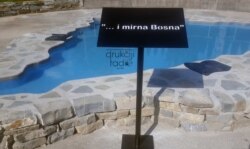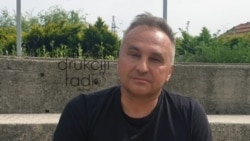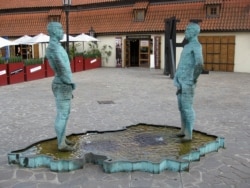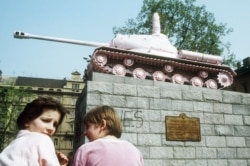VITEZ, Bosnia-Herzegovina -- Having dabbled in art, Bosnian entrepreneur Mirko Sakic now wants some "peace" and quiet.
His idyllic hotel complex in central Bosnia-Herzegovina last week removed three figures "urinating" over a Bosnia-shaped pool after complaints that the art installation was offensive and exacerbated tensions in the ethnically divided Balkan state.
They had called it Harmony (Sloga).
Sakic and one of the artists he commissioned the art from admitted to RFE/RL's Balkan Service that they underestimated the furor that their effort at satire and invitation to "free interpretation and thinking" would cause before it was "replaced" on May 22, just 10 days after it was installed.
"We only wanted to point out the situation in society in every area using satire, but everything got political and I didn't want to get into it," Sakic, a prominent local entrepreneur and owner of the Ethno Hotel Cardaci that housed the artwork in the town of Vitez, told RFE/RL.
Sakic and the daughter-and-father team he commissioned for it modeled Harmony on a 2004 installation lampooning pettiness and rivalries by one of the bad boys of the postcommunist art scene, Czech David Cerny.
Now the Bosnia-shaped pool, retitled ...And Peaceful Bosnia, lies nearly unadorned.
Sakic said what he called the "second phase" of the installation confronted the problem of the continuing outward migration of Bosnians, one of the country of around 3 million people's greatest obstacles to prosperity.
"I decided that the most elegant way to deal with this is humor [and] putting this new installation in place," Sakic said.
'No One Specific'
The Cardaci hotel wrote on Facebook as the criticisms mounted that it envisioned and commissioned the artwork as a reflection on the former Yugoslav republic's "[non]opportunities, but also as a display of the emotions of all of us who face a large amount of negative news, scams, and pessimism."
Some of those problems "are associated with the state," it said, but "its goal is to remind us of the spirit, humor, and other people who live here."
"We are aware that the installation will definitely add different meaning [in a positive and negative sense], but it doesn't show anyone specific," the hotel post added.
In fact, many Bosnians interpreted the three urinating figures in the original installation as representative of the tripartite presidency that reflects the country's three main ethnic groups.
Bosnia was divided along ethnic lines by the 1995 Dayton agreement that ended three years of war that cost tens of thousands of lives.
Although it helped overcome obstacles to peace at the time, the resulting structure -- a weak central government with most powers devolved to a Muslim and Croat federation dominated by Bosniaks and ethnic Croats and a Republika Srpska dominated by ethnic Serbs -- has hampered effective government and allowed rivalries to thrive.
The Vitez branch of the country's main Bosniak party, the Party of Democratic Action, condemned the installation on May 14 as an "abuse of the freedom of expression" and an insult to the Bosnian state, its citizens, and "patriots."
Pro- And Anti-Social Media
Some bruising comments appeared under the hotel's May 14 Facebook post explaining the artwork, accusing the artists and owner of crossing a line.
"Peeing on my homeland for which many gave their lives, limbs, their youth is not and will never be OK," said one. "They did not die for someone to pee on it, and there are those of us who would still die for it today."
"My country, the one and only. Shame on you," another commented.
Another called it simply "tasteless."
But there were many positive responses, too.
One user called it "probably the smartest monument in [Bosnia] and the most accurate depiction of the situation in the country."
Another suggested that "the negative comments are from those who vote for those three nationalists who are literally pissing on us. Kudos to the artist, a very creative display. If anyone is bothered by that, the elections are in October, let that change."
Still another argued that the art was on private property and "everyone has the right to do what they want on their property."
Ethno Hotel Cardaci is an expansive complex of luxuriously rustic facilities set among flagstone trails and bridges, a fishpond, and abundant greenery. It also houses a waterpark.
Owner Sakic is one of the Vitez region's most prominent businessmen, and he hired Kristina and Rajko Livancic to erect Harmony on the hotel's grounds.
The idea was Sakic's, they told RFE/RL's Balkan Service, although they cite Cerny as inspiration on a nearby plaque.
"All those comments didn't surprise me because every work of art carries some kind of 'burden' -- positive or negative," they said. "The aim of art is to provoke and to try to arouse something in each of us.... I couldn’t imagine that everything would turn around so wrong and that we would be labeled people who hate Bosnia-Herzegovina, although the opposite is true."
Made (Up) In Czechia
For further clues to the outrage at the Bosnian installation, look no further than their Czech inspiration.
Cerny has made a career of blunt -- and sometimes vulgar -- confrontations of stereotypes and expectations since he exploded onto the scene as a student in Prague in 1991 by painting a Red Army tank -- which immortalized Soviet tank crews -- pink and affixing a middle-finger gesture on its turret.
To most Czechs, the tank monument was a symbol of a half-century of postwar Soviet occupation.
Cerny's 2004 kinetic sculpture Streams features two opposing male figures standing in a pool in the shape of the Czech Republic and "urinating" toward each other.
The cross-section bronzes appear to be engaging each other from the Czech and Moravian capitals, Prague and Brno, and their pelvises and penises move to splash out quotes from famous Prague denizens or texts from visitors via SMS.
Cerny told RFE/RL that he was no great fan of the European Union at the time and noted that Streams coincided with the Czech Republic's EU accession.
Cerny, who had heard about the Bosnian imitation but not seen it, said he didn't mind it. "She obviously mentioned it, quoted my work, so it's OK," Cerny said. "It's like doing a cover of music. We're in a postmodern era, so nobody cares whether you are the author anymore."
Cerny's Streams is itself a twist on the world's most famous urinating statue, Jerome Duquesnoy the Elder's cherubic 17th-century bronze in Brussels known as Manneken Pis.
"The ideas are gone once you exhibit it -- at that moment, it is public. Anybody can copy it," Cerny said of the current creative atmosphere.
In the context of the Bosnian scandal, Cerny noted that in 2005 he parodied British artist Damien Hirst's 1991 installation The Physical Impossibility Of Death In The Mind Of Someone Living. Instead of Hirst's tiger shark, though, Cerny encased a likeness of former Iraqi dictator Saddam Hussein, who was on trial at the time by a special Iraqi tribunal for crimes against humanity, tied up in his underwear in a massive glass-and-steel tank in a work he called Shark.
The piece was banned in several European cities, including some in Germany, Poland, and Belgium.
Some of Cerny's other works include Tower Babies (2000), overgrown infants with puckered faces suspended ant-like on a formerly futuristic Prague TV tower; London Booster, a red doubledecker bus whose muscled arms performed pushups in London during the 2012 Summer Olympics; and Entropa, a model-kit mockup and "hoax" art aimed at skewering political, economic, and cultural stereotypes that got Cerny into hot water with the Czech government.
But the artist has been an outspoken critic of anything communist ever since, too.
Prague city officials in 2004 withdrew plans to commission a World War II memorial by Cerny to coincide with the 60th anniversary of the end of that conflict after he was quoted as saying, "A good communist is a dead communist."
After he painted the Prague tank monument pink in 1991 -- more than a year after then-Czechoslovakia's Velvet Revolution -- Cerny was arrested under anti-hooliganism laws and the tank returned to its original color. But then more than a dozen newly elected, anti-Soviet, Czech lawmakers repainted it pink again in solidarity with the newest bad boy of the Czechoslovak art scene.
The original dedication of that Soviet monument in 1945 was presided over by Marshal Ivan Konev, whose leadership of the Red Army and occupying forces still afflicts Prague-Moscow relations and historical art in the Czech capital.
Czech media, citing intelligence sources, recently accused Russia of dispatching an intelligence officer to Prague with ricin in his briefcase in a possible plot to poison at least one Prague official after a Konev statue was removed in April.
Russia has dismissed the allegation as "fabrications," but it has called the rationale for removing it "childish" and demanded that it be returned to the public plinth where it had stood since 1980.
At one point, in apparent homage to Cerny's tank, the Konev statue was vandalized with a splash of pink paint.
















